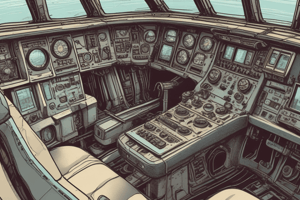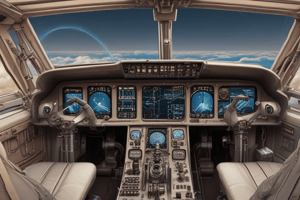Podcast
Questions and Answers
What is the primary function of an autopilot system on a vessel?
What is the primary function of an autopilot system on a vessel?
- To automatically manage the engine room operations
- To automatically clean the deck of the vessel
- To automatically cook meals for the crew
- To automatically steer the vessel and maintain heading (correct)
An autopilot system completely eliminates the need for any human oversight during navigation.
An autopilot system completely eliminates the need for any human oversight during navigation.
False (B)
What two types of vessel course data are compared by an autopilot system?
What two types of vessel course data are compared by an autopilot system?
Course-to-steer data and actual course data
The autopilot applies ______ correction to compensate for errors detected between the input signals.
The autopilot applies ______ correction to compensate for errors detected between the input signals.
What is the purpose of proportional control in an autopilot system?
What is the purpose of proportional control in an autopilot system?
Using only proportional control, a vessel will always steer a perfectly straight course.
Using only proportional control, a vessel will always steer a perfectly straight course.
Using only proportional control, what effect on steering will cause the vessel to oscillate to either side?
Using only proportional control, what effect on steering will cause the vessel to oscillate to either side?
The erratic course steered when using only proportional control can lead to an increase in fuel ______.
The erratic course steered when using only proportional control can lead to an increase in fuel ______.
What is the main function of derivative control in an autopilot system?
What is the main function of derivative control in an autopilot system?
Derivative control electronically differentiates the desired error signal.
Derivative control electronically differentiates the desired error signal.
What action returns the rudder to the amidships position at 'Point X'?
What action returns the rudder to the amidships position at 'Point X'?
What happens when the autopilot is again operated by ____ forces acting on the vessel?
What happens when the autopilot is again operated by ____ forces acting on the vessel?
What does integral control primarily use to determine its data?
What does integral control primarily use to determine its data?
Integral control acting alone will guarantee a perfect return to the original course.
Integral control acting alone will guarantee a perfect return to the original course.
What does data signals, for integral control, produce by continuously sensing?
What does data signals, for integral control, produce by continuously sensing?
Data signals produces by continuously sensing the heading error over a period and applying an appropriate degree of ______ helm.
Data signals produces by continuously sensing the heading error over a period and applying an appropriate degree of ______ helm.
Besides the main controls (proportional, derivative and integral), what controls normally have on autopilots?
Besides the main controls (proportional, derivative and integral), what controls normally have on autopilots?
In the Auto mode, the heading information from a heading sensor is continuously compared with the course that is set on the operator's course.
In the Auto mode, the heading information from a heading sensor is continuously compared with the course that is set on the operator's course.
What two actions brings the vessel back on track?
What two actions brings the vessel back on track?
When a ship is on course, these two signals are ______.
When a ship is on course, these two signals are ______.
What happens to the difference between the primary heading and the set course if the ship drifts off course?
What happens to the difference between the primary heading and the set course if the ship drifts off course?
If the ship drifts off course, there will be an balance at a comparator.
If the ship drifts off course, there will be an balance at a comparator.
Where in the system until a balanced condition is obtained?
Where in the system until a balanced condition is obtained?
What unit monitoring the rudder 'direction'?
What unit monitoring the rudder 'direction'?
Match the autopilot steering modes with their descriptions:
Match the autopilot steering modes with their descriptions:
Flashcards
Automatic Pilot
Automatic Pilot
An automatic device for steering a vessel and maintaining its heading in an intended direction.
Helm Data
Helm Data
Data regarding the vessel's movement relative to the course to steer line.
Proportional Control
Proportional Control
A control method where the rudder moves proportionally to the positional error.
Proportional Control effect
Proportional Control effect
Signup and view all the flashcards
Vessel Oscillation Result
Vessel Oscillation Result
Signup and view all the flashcards
Derivative Control
Derivative Control
Signup and view all the flashcards
Integral Control
Integral Control
Signup and view all the flashcards
Integral Control Data Signals
Integral Control Data Signals
Signup and view all the flashcards
Heading Information
Heading Information
Signup and view all the flashcards
Off-Course Alarm
Off-Course Alarm
Signup and view all the flashcards
Auto Mode
Auto Mode
Signup and view all the flashcards
Nav. Mode
Nav. Mode
Signup and view all the flashcards
Track Mode
Track Mode
Signup and view all the flashcards
Non-Follow up (NFU) Mode
Non-Follow up (NFU) Mode
Signup and view all the flashcards
Follow-up mode (FU)
Follow-up mode (FU)
Signup and view all the flashcards
Advantages of autopilot
Advantages of autopilot
Signup and view all the flashcards
Study Notes
- An autopilot is an automatic device that steers a vessel and maintains its heading in a intended direction
- Ship operators can appreciate the advantages of the autopilot as it steers the ship, freeing them to carry out navigational checks
- The autopilot compares desired course data, set by the helmsman, with actual course data from a gyro or magnetic compass
- It then applies rudder corrections to compensate for any error detected between these signals
Main Control Methods
- Vessels must be provided with data regarding its movement relative to the desired course line for accurate course holding
- Three main control functions affected by data inputs are proportional, derivative, and integral control
Proportional Control
- Proportional control means equal
- The rudder moves by an amount proportional to the positional error from the course line
- When only proportional control is applied, the vessel will oscillate on either side of the desired course
- The vessel eventually reaches its destination, but the erratic course increases fuel consumption
Derivative Control
- The rudder shifts by an amount proportional to the rate of change of the vessel's deviation from its course
- This is achieved by electronically differentiating the actual error signal
- Corrective starboard rudder is applied when course error is sensed
- The rate-of-change decreases, causing automatic rudder control to decrease
- The rudder returns to amidships position at Point X
- The vessel will continue parallel to the required course until the autopilot is acted on by external forces
Integral Control
- Combines proportional and derivative control for a more satisfactory return to course
- Data for integral control is derived by electronically integrating the heading error
- This offsets the effect of a vessel continuously moving off course
- Data signals are produced by continuously sensing the heading error over a period and applying an appropriate degree of permanent helm
- Autopilots normally include yaw, trim, draft, rudder limit, and weather controls
Comparator
- When a ship is on course, two signals are equal
- If the ship drifts off course, the difference between the primary heading and the set course changes proportionally
- This causes an imbalance at a comparator
- The comparator's output moves up or down depending on the difference in course
- The rudder turns the vessel to obtain a balanced condition at the comparator, then the drive to the rudder stops
- A rudder reference unit determines rudder position and direction, and it is continuously monitored by the processor unit
Block Diagram of Autopilot System
- An output from a gyro or magnetic compass is coupled to a differential amplifier with a signal from a manual course-setting control
- With no signal difference, the amplifier produces no output
- This means there will be no rudder movement
- An output signal that is proportional to the off-course error is produced if a difference exists between the compass and selected course inputs
- An output error signal, proportional in magnitude to the difference, is applied to the heading error amplifier
- The output of this amplifier causes the rudder actuator circuit to move the rudder in the direction of the output signal's sign
Alarm
- An off-course alarm circuit senses the error signal at the output of the heading error amplifier
- When signal amplitude falls outside of pre-determined limits, an audible alarm sounds
Basic Steering Modes
- Auto mode performs automatic course keeping using heading data from the gyrocompass and the operator's order setting
- Some devices monitor dynamic parameters, continuously adapting the steering control output
- This provides course keeping with minimal rudder motion and maximum efficiency.
- Nav mode performs automatic course keeping using inputs from an external navigation system to steer the ship toward a waypoint
- In NAV mode the external navigation system determines course to steer
Track Mode
- Track mode performs automatic course keeping using inputs from an external navigation system, corrected for cross track error by the autopilot
- This steers the ship toward a waypoint over a designated track over the ground.
Non-Follow Up (NFU) Mode
- This mode allows the operator to directly control the steering gear pump oil flow into the steering actuators
- Operating the NFU control causes the rudder to rotate portside or starboard side as long as the control is held
- When the control is released, the rudder remains stationary until the NFU controller is operated again, or the steering mode is changed
- The helmsman sets the desired rudder angle by observing the rudder angle indicator and operating the NFU control
Follow-Up (FU) Mode
- All autopilot functions apply
Advantages of Autopilot
- Reduce the number of deck crew
- Considerable saving in fuel is achieved
- Minimizes deviation of the steering course
- Decrease sailing time of the voyage.
- The OOW can concentrate on other issues (i.e. navigation).
Studying That Suits You
Use AI to generate personalized quizzes and flashcards to suit your learning preferences.




